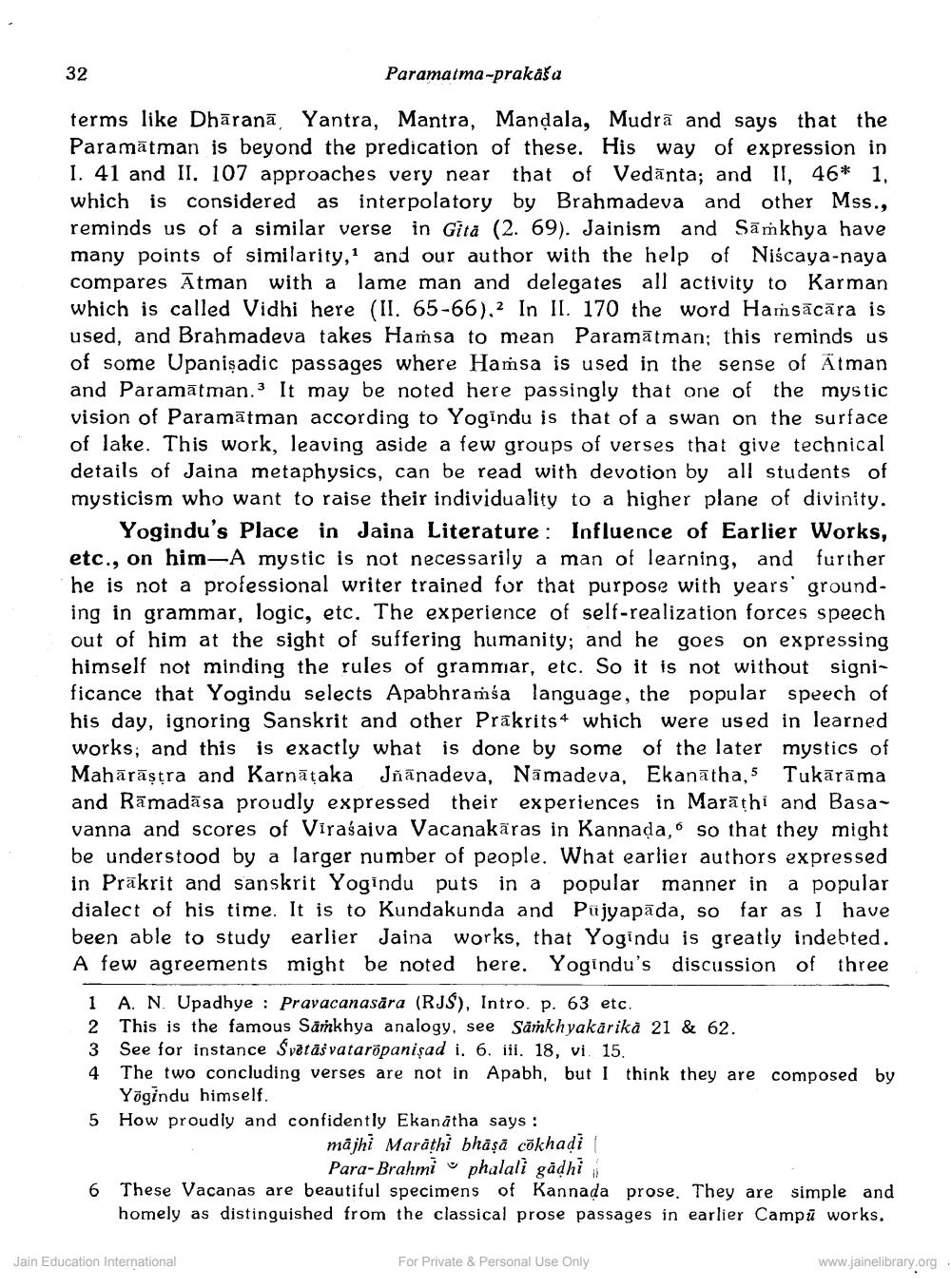________________
32
Paramatma-prakaša
terms like Dhāranā Yantra, Mantra, Mandala, Mudrā and says that the Paramātman is beyond the predication of these. His way of expression in I. 41 and II. 107 approaches very near that of Vedānta; and II, 46* 1, which is considered as interpolatory by Brahmadeva and other Mss., reminds us of a similar verse in Gita (2. 69). Jainism and Sāmkhya have many points of similarity,' and our author with the help of Niscaya-naya compares Ātman with a lame man and delegates all activity to Karman which is called Vidhi here (II. 65-66),2 In II. 170 the word Hamsācāra is used, and Brahmadeva takes Hamsa to mean Paramātman; this reminds us of some Upanisadic passages where Hamsa is used in the sense of Atman and Paramātman.3 It may be noted here passingly that one of the mystic vision of Paramātman according to Yogindu is that of a swan on the surface of lake. This work, leaving aside a few groups of verses that give technical details of Jaina metaphysics, can be read with devotion by all students of mysticism who want to raise their individuality to a higher plane of divinity.
Yogindu's Place in Jaina Literature: Influence of Earlier Works, etc., on him-A mystic is not necessarily a man of learning, and further he is not a professional writer trained for that purpose with years' grounding in grammar, logic, etc. The experience of self-realization forces speech out of him at the sight of suffering humanity; and he goes on expressing himself not minding the rules of grammar, etc. So it is not without significance that Yogindu selects Apabhramśa language, the popular speech of his day, ignoring Sanskrit and other Prakrits 4 which were used in learned works; and this is exactly what is done by some of the later mystics of Mahārāstra and Karnātaka Jñānadeva, Namadeva, Ekanātha, 5 Tukārāma and Rāmadāsa proudly expressed their experiences in Marāthi and Basavanna and scores of Viraśaiva Vacanakāras in Kannada, so that they might be understood by a larger number of people. What earlier authors expressed in Prākrit and sanskrit Yogindu puts in a popular manner in a popular dialect of his time. It is to Kundakunda and Pujyapāda, so far as I have been able to study earlier Jaina works, that Yogindu is greatly indebted. A few agreements might be noted here. Yogindu's discussion of three 1 A. N. Upadhye : Pravacanasāra (RJS), Intro. p. 63 etc. 2 This is the famous Saṁkhya analogy, see Sänkhyakarikå 21 & 62. 3 See for instance Svētās vatarōpanişad i. 6. iii. 18, vi. 15. 4 The two concluding verses are not in Apabh, but I think they are composed by
Yogindu himself. 5 How proudly and confidently Ekanātha says:
mājhi Marathi bhāșă cokhadi
Para-Brahmi phalali gadhi 6 These Vacanas are beautiful specimens of Kannada prose. They are simple and
homely as distinguished from the classical prose passages in earlier Campū works.
Jain Education International
For Private & Personal Use Only
www.jainelibrary.org




